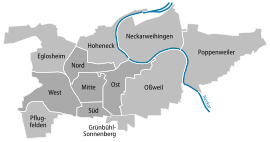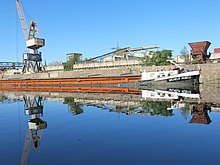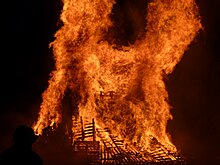Neckarweihingen
|
Neckarweihingen
City of Ludwigsburg
|
|
|---|---|
| Coordinates: 48 ° 54 ′ 35 " N , 9 ° 13 ′ 25" E | |
| Height : | 213 m |
| Area : | 3.52 km² |
| Residents : | 6910 (December 31, 2015) |
| Population density : | 1,963 inhabitants / km² |
| Incorporation : | 1st January 1974 |
| Postal code : | 71642 |
| Area code : | 07141 |
Neckarweihingen is a district of the district town of Ludwigsburg , which was incorporated on January 1, 1974.
Geographical location
Neckarweihingen is located northeast of the city center on the right bank of the Neckar and is surrounded by a loop of the Neckar . In the north and northeast, Neckarweihingen borders on Marbach am Neckar , in the east on Poppenweiler , in the south on Oßweil and Ludwigsburg-Ost and in the west on Hoheneck . Neckarweihingen is about 15 kilometers away from downtown Stuttgart .
history
The first documented mention of Neckarweihing comes from the year 1291 ; it speaks of a parish de Wihingen and the Neckar. Older mentions of a farm ( curia ) in Weihingen ( Wihigin / Wihingen ) from the years 1271 or 1275 were, however, provided with question marks in the research, as they could also refer to Enzweihingen . It is assumed that the village belonged to the margraviate of Baden due to the close connection to Hoheneck and came to the county of Württemberg in 1360 . The place was mainly inhabited by wine growers and ferrymen. In 1634 the village was largely destroyed during the Thirty Years War . Destruction also occurred in the Palatinate War of Succession in 1693. During the construction of the Ludwigsburg residence in 1722, a wooden bridge was built over the Neckar in Neckarweihingen.
The place was expanded in the 19th century. Among other things, a school building and two baking houses were built. In 1862 the old wooden bridge was torn down and replaced by a stone bridge; it was blown up by the Wehrmacht during World War II . Temporarily repaired with a wooden structure, it made way for a prestressed concrete bridge in 1955 , which Paul Bonatz helped design . From 1911 to 1926 Neckarweihingen was connected to Ludwigsburg by the Ludwigsburg overhead line railways , but their "Neckarbrücke" stop was on the opposite bank of the Neckar. In 1957 the new town hall was inaugurated. In the 1960s, many old buildings, including the old town hall, fell victim to the renovation. As part of the community reform , Neckarweihingen was incorporated into Ludwigsburg on January 1, 1974.
badges and flags
The Neckarweihingen coat of arms shows, in gold, a four-legged black grate with a stem and ring pointing upwards under a black stag pole.
The coat of arms was awarded to the former municipality together with a black and yellow flag on January 25, 1958. The stag bar indicates that it belongs to Württemberg, the rust is the attribute of the Neckarweihinger church saint Laurentius .
Attractions
- Evangelical Laurentius Church
- Friedrich von Keller School, built in 1966 based on a design by Günter Behnisch
- Kiesranzenbrunnen
Sports
- Bicycle and motor vehicle association 06 (RKV 06) Neckarweihingen
- Gymnastics Club Neckarweihingen 1899
Economy and Infrastructure
traffic
Neckarweihingen is connected to the rest of Ludwigsburg via the Neckar Bridge and Marbacher Straße. A renovation of the bridge has already been considered several times because it is in need of renovation. However, the renovation was postponed year after year for cost reasons. The bridge built in 1955 was renovated from March 2017 to the end of June 2018. Neckarweihingen is directly connected to Marbach am Neckar via the L 1100.
Established businesses
The following companies have their headquarters in Neckarweihingen:
- The Jetter AG , a manufacturer of programmable logic controllers (PLC).
- Deutsche Vortex GmbH & Co. KG, a manufacturer of service water and heating pumps and a member of the Grundfos Group.
- Heidelberg Postpress Deutschland GmbH, a manufacturer of folding machines and a subsidiary of Heidelberger Druckmaschinen AG .
- Leopold Verpackungen GmbH with headquarters and a plant. Leopold is a manufacturer of packaging in Germany and Europe.
Festivals
- Large carnival parade: usually in February with over 80 participating groups and up to 20,000 visitors.
- Kiesranzenfest : Street festival in June with an extensive children's program along the main street, which is closed for a weekend.
- Midsummer bonfire with youth action day
- Autumn holiday program of the clubs with autumn festival
Personalities
- Friedrich von Keller (1840–1914), painter
Web links
Individual evidence
- ↑ Wirtembergisches Urkundenbuch, Vol. IX, p. 447 f. No. 4106 ( WUB online ).
- ↑ Wirtembergisches Urkundenbuch, Vol. VII, p. 158 f. No. 2235 ( WUB online ).
- ↑ Wirtembergisches Urkundenbuch, Vol. VII, p. 159 No. 2237 ( WUB online ).
- ↑ Wirtembergisches Urkundenbuch, Vol. VII, p. 159 No. 2238 ( WUB online ).
- ↑ Wirtembergisches Urkundenbuch, Vol. VII, pp. 350 f., No. 2480 ( WUB online ).
- ↑ See Lutz Reichardt: Book of place names of the Stuttgart district and the Ludwigsburg district. Stuttgart 1982 (Publications of the Commission for Historical Regional Studies in Baden-Württemberg. Series B. Vol. 101), p. 164 f.
- ↑ Roland May : Pontifex maximus. The architect Paul Bonatz and the bridges. Monsenstein and Vannerdat , Münster iW 2011, ISBN 978-3-86991-176-2 , pp. 472f., 589f., 663.
- ^ Federal Statistical Office (ed.): Historical municipality directory for the Federal Republic of Germany. Name, border and key number changes in municipalities, counties and administrative districts from May 27, 1970 to December 31, 1982 . W. Kohlhammer, Stuttgart / Mainz 1983, ISBN 3-17-003263-1 , p. 462 .
- ↑ https://www.lkz.de/lokales/stadt-ludwigsburg_artikel,-nachgehakt-_arid,495680.html
- ↑ http://www.stuttgarter-zeitung.de/inhalt.bruecke-in-neckarweihingen-neckarbruecke-wird-bis-oktober-saniert.90b157d1-2d01-4819-b6ea-9a18f2288c72.html
- ↑ www.kiesranzenfest.de




